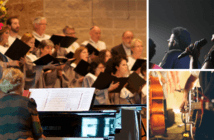How can a congregation effectively engage younger adults? The Faith Communities Today (FACT) study provides some clues. As part of the largest ongoing religious research project in the U.S., the study focused on the active involvement of young adults in participating faith communities and involved a multi-year examination of ten congregations with a sizable presence of young adults between the ages of 18 and 35. These ten congregations were diverse in every aspect, including size, ethnicity, and faith tradition. These case studies and other qualitative data revealed some key lessons in how to attract and engage younger adult populations.
All of the congregations studied offered programs and worship that challenged young adults to grow in various aspects of their lives, but each congregation did this in a way consistent with its own values.
Be intentional in engaging young adults. Congregations in the FACT study initiated programming with the intent to engage young adult populations in their surrounding contexts, whether urban, rural, or suburban. It was not haphazard or accidental. In the areas of worship, budgeting, service, or governance, these congregations were strategic in cultivating young adult participation and creating space for young adults to exercise their gifts. They displayed a willingness to “make room” for young adults and “envisioned” them into the life of the community. The churches sought input from young adults to plan, build, and implement programming for their age group.
Be true to yourself. Key to the intentional actions of these congregations was a strong sense of identity. The FACT study congregations discerned a role for young adults as part of their communal identity and found ways to enact that vision. In one of the churches studied, young adults attributed their involvement in the church to the congregation’s strong Roman Catholic identity. The young adults became deeply involved because they appreciated how the congregation lived out its values. Ultimately, the essential work of attracting and engaging younger adults requires congregations to recommit to their identity and the values that shape their communities.
Integrate, don’t assimilate. Vibrant congregations have a culture of “integration” as opposed to “assimilation.” The etymological root of assimilation means “to make alike,” while integration simply means be “part of.” A culture of integration rather than assimilation frees young adults from rigid conformity and allows them to be who they are. The congregations studied exhibited a form of inclusivity, a culture of integration that invites young adults to exercise their gifts and abilities in ways that best suit them. They accept young adults “as they are” and work deliberately to connect them to the broader community. Young adults feel welcome and report a sense that they have a place integral to congregational life. The resulting affirmation encourages participation from young adults in areas of visibility, including worship, faith formation classes, service activities, and governing committees. FACT contributor and religious researcher LiErin Probasco explained that these vibrant congregations “meet young adults where they are on their faith journey.” They embody a “come as you are” and “be what you will” attitude.
Offer challenging programs addressing real-life needs. Too often, church leaders provide younger adults what they think young adults want and need rather than what young adults really want and need. The FACT study revealed that vibrant congregations strategically invest in young adults in ways that build on their real needs, both spiritual and physical, and provide opportunities for growth. All of the congregations studied offered programs and worship that challenged young adults to grow in various aspects of their lives, but each congregation did this in a way consistent with its own values. These programs and activities were oriented toward creating community and faith formation. They offered fellowship and challenge. They accepted young adults and provided space for them to exercise their gifts in the community. They also equipped them to address the challenges of their lives.
Be innovative, not contemporary. Many congregations seek to be relevant to young adults with “contemporary” worship, language, or décor, while retaining traditional values. However, the FACT study reveals that being “innovative” may be more important than being “contemporary.” The difficulty with the contemporary mindset is that it can quickly become static, such as the many “contemporary” worship services that are stuck in the practices of the 1980s. Innovation refers to the readiness and adaptability of a congregation to address its present context for ministry. Innovation is characterized by a willingness to entertain the new and effective ideas for the sake of relevance. With innovation as a mindset, ministry is contemporary. An example from the study is the role of innovation and technology. Technology is not what makes ministry relevant, but innovation views technology as a vehicle to be relevant.
Information on the FACT reports, specific case studies, and the aggregate data is available at https://faithcommunitiestoday.org/increasing-young-adult-participation-churches-and-other-faith-communities.
Related Resources:






